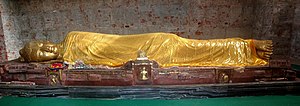Talk:Gautama Buddha
Image of paranirvana
Life of the Buddha according to the Pali Canon
Could be interesting to have a paragraph or section about this, interesting variations e.g. both Buddha's parents alive when he sets forth, they see him off (not secret), and nothing to suggest he is married or has a son at the time. See my blog post for the sutra sources and summary. Do get the traditional account but as the life of Vipassa, first of Buddhas in our world system and presented over vast time scales, 10,000 years between each of the four sights.
Blogs:Robert Walker/Life of the Buddha according to the sutras
Robert Walker (talk) 15:46, 6 August 2018 (UTC)
Historical Buddha oligarchy or republic
In the historical account section, this seems strange to me:
It was either a small republic, in which case his father was an elected chieftain, or an oligarchy, in which case his father was an oligarch"
So, I looked it up - it does not acutally correctly paraphrase what Gombrich wrote. He actually describes what he thinks the society was like in some detail and then says "Some historians call this an oligarchy, some a republic"
This is what he says
Buddha came from a community called (in Sanskrit) Sakyas; hence his commonest Sanskrit title, Sakyamuni, ‘the Sage of the Sakyas’.This fact is of great historical importance, because according to the Buddha (or, strictly speaking, according to words attributed to him in the MahaParinibbana Sutta) he modelled the organization of his Sangha on that of such communities as his own. Historians usually call these communities ‘tribes’, but I am wary of that term, which corresponds to no word in Sanskrit or Pali. ‘Tribe’ evokes an isolated community with no socially structured inequality. The Sakyas seem not to have had a varna system but they did have servants. They were isolated to the extent that they were self-governing, and their polity was of a form not envisaged in brahminical theory. We deduce that the heads of households – maybe only those above a certain age or otherwise of a certain standing – met in council to discuss their problems and tried to reach unanimous decisions. Some historians call this an oligarchy, some a republic; certainly it was not a brahminical monarchy, and makes more than dubious the later story that the future Buddha’s father wasthe local king. This polity presented the Buddha with a model of how a casteless society could function. In the Sangha he instituted no principle of rank but seniority, counted in that case from ordination; maybe age was the ranking principle in the Sakya council."
That's in his "Theravada Buddhism: A social history from ancient Benares to modern Colombo"
There is more background here in page 123 of: State and Government in Ancient India, By Anant Sadashiv Altekar
Robert Walker (talk) 23:29, 6 August 2018 (UTC)
